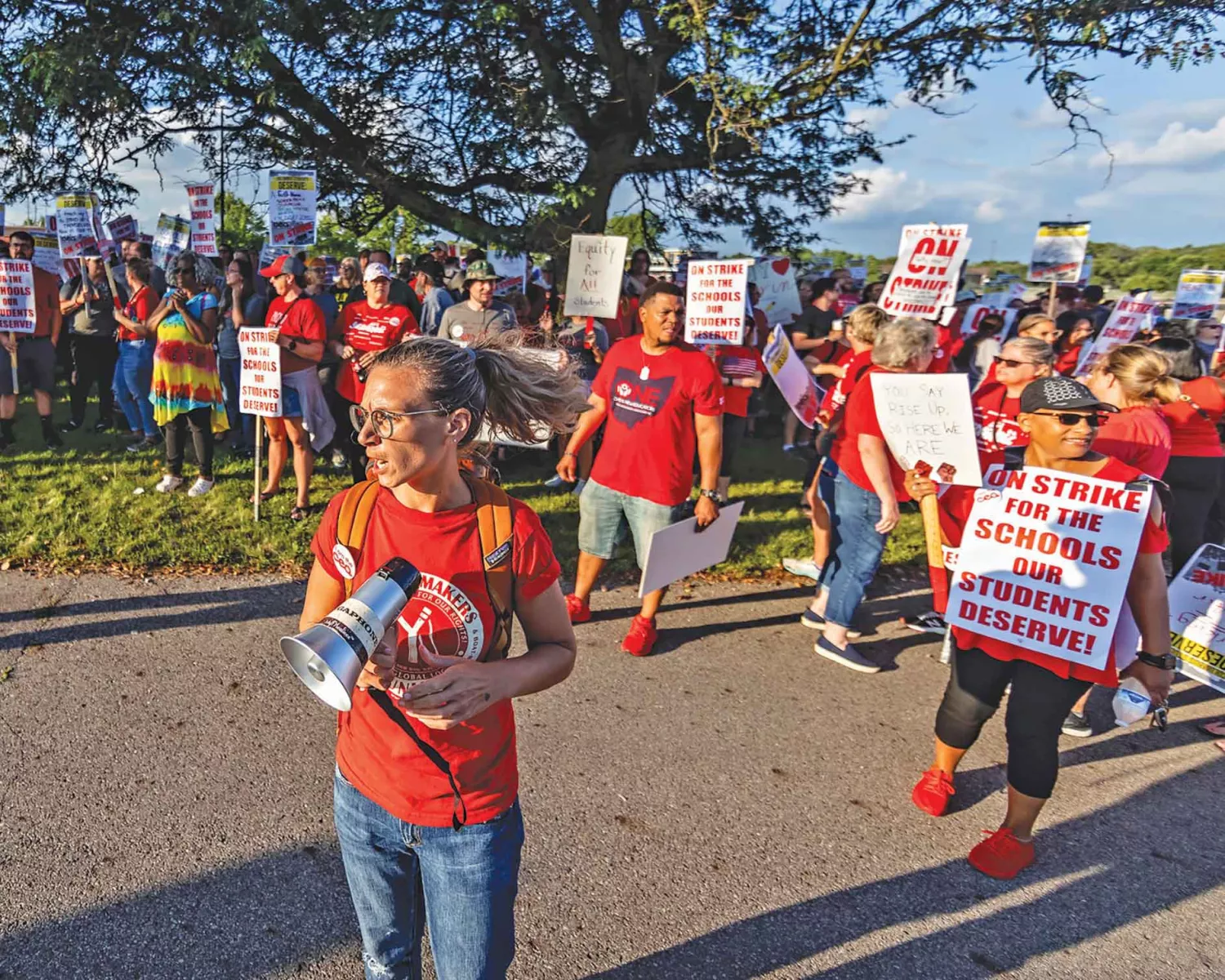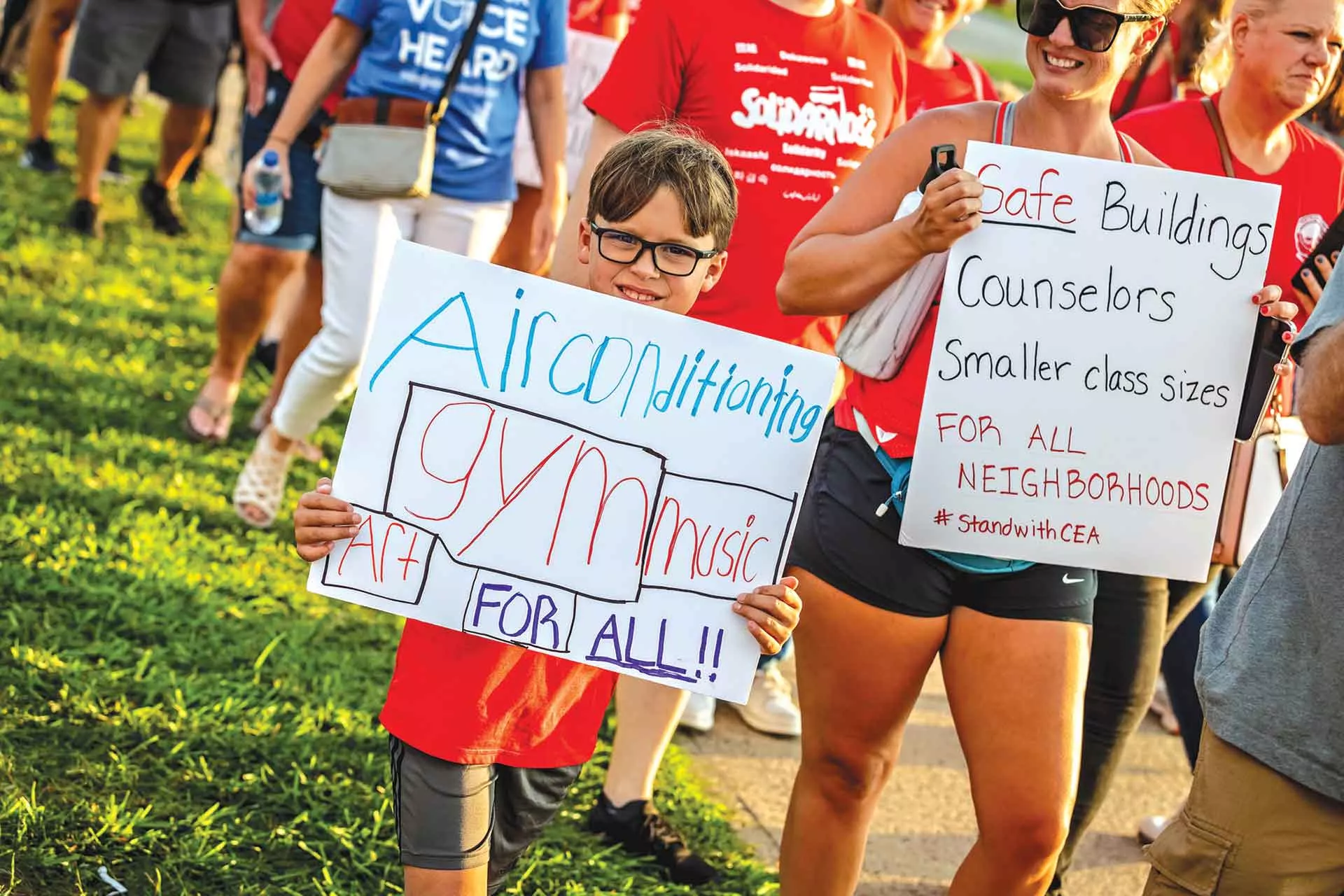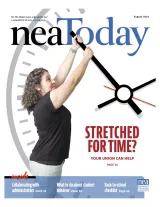When Joe Decker walked into his classroom on the first day of school last year, he got chills. Liter-ally and figuratively. His school finally got air conditioning!
“I was a little teary-eyed, to be honest,” he says.

A year earlier, in August 2022, Decker and his colleagues in the Columbus Education Association (CEA) had gone on strike—and one of the chief reasons was to compel Ohio’s largest school district to invest in safe, well-maintained school facilities. At the time, about a quarter of the city’s schools didn’t have air conditioning. In an attempt to improve learning conditions, Decker, a social studies teacher at Mifflin Middle School, bought his own industrial fan from Lowe’s and tried not to drip sweat on students’ desks or papers.
Today, things are different. Every school in Columbus has air conditioning. Class sizes are lower in every grade. Art teachers have classrooms instead of carts. Educators have paid family leave! And pay is higher, too. What’s more, Columbus’ first community school is in the works.
Quote byKelsey Gray , High school English teacher
Two years after CEA’s three-day strike—and all the organizing work that led up to it—the results are both measurable and immeasurable. The union got stronger. And it’s still flexing its muscle today.
“What the strike brought us, for sure, is that sense of solidarity,” says high school English teacher Kelsey Gray. “And I think we maintain it through organizing actions.”
Strikes build power
In 2022, the picket line brought parents and educa-tors together, and bridged common gaps between academic teams or depart-ments. Union members felt a part of something powerful, educators recall. “It was the best professional development we ever had,” Gray says.
But it’s not like you walk into school the day after a strike ends and all is better, she adds. Everything was the same, except educators—especially union leaders—were even more exhausted than usual.
One significant change did happen fast: Within months of the strike, school-based substitutes moved to join CEA. These educators had been the only full-time, frontline employees in Columbus City Schools without union representation. Not only were they poorly paid, they also didn’t have a voice, notes Kim Maupin, who became a building sub after a 32-year teaching career.
“We are teachers—we are teaching—but we weren’t being recognized or respected for that work," she says. In 2023, the subs' first-ever union contract not only boosted their pay, but also provided paid family leave and professional development.

'We are the union!'
In 2023, CEA’s “member action team” rolled back into high gear when Columbus City Schools proffered a new tax levy to infuse nearly $100 million into public schools. Frankly, it looked like it was going to fail, says Izetta Thomas, lead organizer for the Columbus Education Justice Coalition.
Thomas, a former special education teacher, has led conversations with more than 1,000 community members over the past two years. She says she has found that many residents don’t think the district “speaks to them,” or invests adequately in their students. “A lot of our folks [are] tired of the status quo, tired of a district manag-ing decline,” Thomas says.
The levy would help fulfill the promise of better, safer schools, but the school board was doing a poor job of talking to voters. Weeks before the election, only 36 percent of voters supported it. So, union members stepped up and mobilized their partners.
3 Things That Changed after the Strike
-
Family leave. “I was like 10 weeks pregnant when we went on strike,” says art teacher Annelise Taggart. That turned out to be excellent timing! Under the old contract, “paid family leave” didn’t exist. Teachers used sick leave, if they had it. Under the new contract, Taggart first accessed 10 days of sick leave from the teachers’ sick leave bank, and then the district covered an additional 20 paid days—for a minimum of six weeks of paid leave. “It was a huge weight lifted off my shoulders!” she says.
-
Heating and air conditioning. “I was a coach for 20 years in a gym that wasn’t air-conditioned,” says high school teacher and longtime coach J Sanchez. Making it worse, the district roofed over his gym’s attic fans. Today, every Columbus school has air conditioning and heat. “Now the gym teacher and students in there can work out without risking death!” Sanchez says.
-
The district's first community school. The 2022–2025 contract provides up to $50,000 a year for a School Transformational Pilot Program. In its first year, the union selected NEA’s community school model. In 2023-2024, they reviewed applications from schools wanting to become Columbus’ first community school. This fall, the transformational work at that school begins!

“We went to the neighborhoods nobody else was going to and did phone banking with the voters nobody else deemed import-ant,” Thomas says. And the levy passed!
Now the school board is talking about closing schools to save money—and, of course, it’ll be schools in communities of color, which can then be turned into for-profit charter schools, Decker says. “Obviously, it’s a Trojan horse to attack public education,” he adds.
But teachers are ready. The key thing they learned two years ago is this: “We are the union,” says art teacher Annelise Taggart. “Our leaders aren’t the only people in the union. It’s all of us.”



